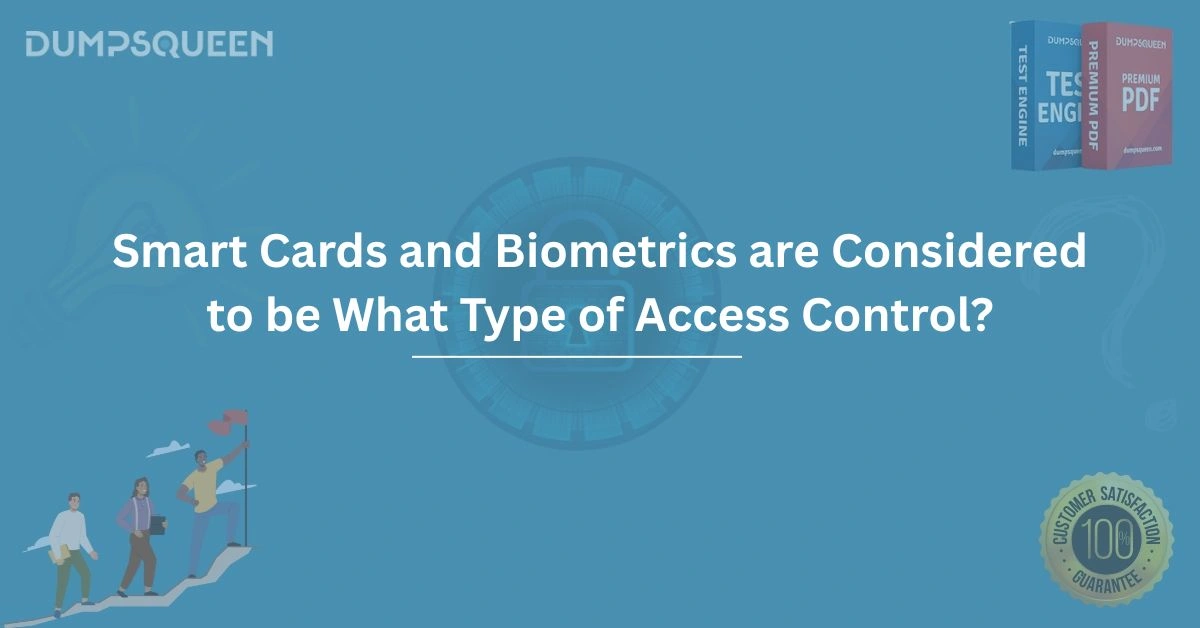Introduction
In today’s rapidly evolving digital landscape, securing sensitive information and restricted areas has become a top priority for organizations across industries. Access control systems play a critical role in ensuring that only authorized individuals gain entry to specific resources, whether physical or digital. Among the various technologies employed, smart cards and biometrics stand out as highly effective solutions. But what type of access control do these technologies represent? This blog explores the intricacies of smart cards and biometrics, their classification within access control systems, and their significance in modern security frameworks. At DumpsQueen, we aim to provide comprehensive insights into cutting-edge technologies to help professionals and organizations stay ahead in their security endeavors.
The Fundamentals of Access Control
Access control is the process of selectively restricting access to resources, systems, or physical locations based on predefined criteria. It ensures that only authorized individuals can perform specific actions, such as entering a building, accessing a computer system, or handling sensitive data. Access control systems are broadly categorized into three types: physical, logical, and administrative. Physical access control governs entry to tangible spaces like offices or data centers. Logical access control manages access to digital systems, networks, or data. Administrative access control involves policies and procedures that dictate how access is granted and managed.
Smart cards and biometrics primarily fall under the umbrella of physical and logical access control, depending on their application. These technologies are integral to what is known as “technical access controls,” which rely on hardware and software to enforce security measures. To understand their classification, it’s essential to delve into the mechanics of smart cards and biometrics and how they align with the principles of access control.
What Are Smart Cards?
Smart cards are pocket-sized plastic cards embedded with integrated circuits or microchips that store and process data. They are widely used for authentication purposes in access control systems. Unlike traditional magnetic stripe cards, smart cards offer enhanced security features, such as encryption and the ability to store complex data, making them resistant to tampering and cloning. Smart cards can be contact-based, requiring physical insertion into a reader, or contactless, using radio frequency identification (RFID) or near-field communication (NFC) to communicate with a reader wirelessly.
In access control, smart cards serve as a credential that verifies the identity of the cardholder. For instance, an employee may use a smart card to unlock a secure office door or log into a company network. The card stores unique identifiers, such as a digital certificate or a personal identification number (PIN), which are validated by the access control system. Smart cards are often combined with other authentication methods, such as PINs or passwords, to create a multi-factor authentication (MFA) system, significantly enhancing security.
The Role of Biometrics in Access Control
Biometrics refers to the measurement and analysis of unique physical or behavioral characteristics to verify an individual’s identity. Common biometric identifiers include fingerprints, facial recognition, iris scans, voice patterns, and even behavioral traits like typing rhythms. In access control, biometric systems compare a user’s biometric data against a stored template to grant or deny access. These systems are highly accurate because biometric traits are unique to each individual and difficult to replicate.
Biometric access control is used in both physical and logical contexts. For example, a fingerprint scanner may be installed at the entrance to a high-security facility, while facial recognition might be used to unlock a smartphone or access a secure application. The primary advantage of biometrics is its convenience—users don’t need to carry cards or remember passwords. However, biometric systems must address concerns related to privacy, data storage, and the potential for false positives or negatives.
Classifying Smart Cards and Biometrics in Access Control
Both smart cards and biometrics are classified as part of “technical access controls” within the broader access control framework. Technical access controls rely on technological mechanisms to authenticate and authorize users. They are often associated with the “something you have” (smart cards) and “something you are” (biometrics) factors of authentication. These factors are part of the multi-factor authentication model, which also includes “something you know” (e.g., a password or PIN).
Something You Have: Smart Cards
Smart cards represent the “something you have” factor because they are physical objects that the user must possess to gain access. When a smart card is presented to a reader, the system verifies the card’s credentials, such as a digital signature or encrypted key, to authenticate the user. This makes smart cards highly effective for securing both physical spaces (e.g., office buildings) and logical systems (e.g., computer networks). Their portability and ability to integrate with other authentication methods make them a versatile choice for organizations.
Something You Are: Biometrics
Biometrics corresponds to the “something you are” factor, as it relies on an individual’s unique biological or behavioral characteristics. Biometric systems authenticate users by comparing real-time scans (e.g., a fingerprint or facial image) with pre-registered templates stored in a database. This eliminates the need for physical credentials, reducing the risk of lost or stolen cards. Biometrics is particularly valuable in high-security environments where accuracy and non-repudiation are critical.
Multi-Factor Authentication
Smart cards and biometrics are often combined to create robust multi-factor authentication systems. For example, a user may need to present a smart card and provide a fingerprint scan to access a secure data center. This layered approach significantly reduces the likelihood of unauthorized access, as an attacker would need to compromise multiple authentication factors. At DumpsQueen, we emphasize the importance of MFA in modern security strategies, and our resources provide in-depth guidance on implementing such systems effectively.
Applications of Smart Cards and Biometrics
The versatility of smart cards and biometrics makes them applicable across various industries and use cases. Below are some key areas where these technologies are transforming access control:
Corporate Security
In corporate environments, smart cards and biometrics are used to secure office buildings, restrict access to sensitive areas, and protect IT systems. Employees may use smart cards to enter the workplace and log into their workstations, while biometric scanners ensure that only authorized personnel access restricted areas like server rooms. These technologies help organizations comply with regulatory requirements and safeguard intellectual property.
Healthcare
The healthcare sector relies heavily on access control to protect patient data and medical facilities. Smart cards are used by healthcare professionals to access electronic health records (EHRs) securely, ensuring compliance with regulations like HIPAA. Biometric systems, such as iris scanners, are employed in hospitals to verify the identity of staff and patients, reducing the risk of medical identity theft.
Government and Defense
Government agencies and defense organizations use smart cards and biometrics for high-stakes applications, such as securing military bases, issuing national ID cards, and protecting classified information. For instance, the U.S. Department of Defense uses Common Access Cards (CACs), a type of smart card, to authenticate personnel and grant access to secure systems. Biometric systems are also deployed at border control points to verify travelers’ identities.
Financial Services
In the financial industry, smart cards and biometrics enhance the security of transactions and customer data. Contactless smart cards are widely used for payments, while biometric authentication, such as fingerprint or facial recognition, is integrated into mobile banking apps. These technologies help prevent fraud and ensure a seamless user experience.
Advantages and Challenges of Smart Cards and Biometrics
While smart cards and biometrics offer significant benefits, they also come with challenges that organizations must address to maximize their effectiveness.
Advantages
-
Enhanced Security: Both technologies provide strong authentication mechanisms, reducing the risk of unauthorized access.
-
Convenience: Smart cards are easy to carry, and biometrics eliminates the need for physical credentials.
-
Scalability: These systems can be deployed across small businesses or large enterprises, adapting to various security needs.
-
Compliance: Smart cards and biometrics help organizations meet industry standards and regulatory requirements.
Challenges
-
Cost: Implementing smart card or biometric systems can be expensive, particularly for large-scale deployments.
-
Privacy Concerns: Biometric data is highly sensitive, and organizations must ensure robust data protection measures to prevent breaches.
-
False Positives/Negatives: Biometric systems may occasionally misidentify users, requiring fallback authentication methods.
-
Lost or Stolen Cards: While smart cards are secure, they can be lost or stolen, necessitating robust revocation processes.
At DumpsQueen, we provide resources to help organizations navigate these challenges and implement smart card and biometric systems effectively. Our expertly curated materials offer practical insights into optimizing access control strategies.
The Future of Smart Cards and Biometrics
As technology continues to advance, the role of smart cards and biometrics in access control is expected to evolve. Emerging trends, such as the integration of artificial intelligence (AI) and machine learning, are enhancing the accuracy and efficiency of biometric systems. For example, AI-powered facial recognition can now detect spoofing attempts, such as the use of photos or masks. Similarly, advancements in smart card technology, such as the adoption of blockchain for secure data storage, are making these credentials even more resilient to attacks.
The rise of mobile-based access control is another significant development. Smartphones are increasingly being used as virtual smart cards, leveraging NFC and biometric authentication to provide seamless access to physical and digital resources. This convergence of technologies is creating a more user-friendly and secure access control ecosystem.
Organizations must stay informed about these trends to remain competitive and secure. DumpsQueen is committed to keeping professionals updated on the latest advancements in access control, offering resources that empower individuals to excel in their careers.
Conclusion
Smart cards and biometrics are pivotal components of modern access control systems, offering robust solutions for securing physical and digital environments. Classified as technical access controls, they represent the “something you have” and “something you are” factors of authentication, respectively. Their ability to integrate into multi-factor authentication frameworks makes them indispensable for organizations seeking to protect sensitive resources. While challenges like cost and privacy concerns exist, the benefits of enhanced security, convenience, and compliance far outweigh the drawbacks.
As the demand for secure access control continues to grow, staying informed about smart cards, biometrics, and emerging trends is crucial for professionals and organizations alike. At DumpsQueen, we are dedicated to providing high-quality resources and insights to help you master access control technologies and advance your career. Visit DumpsQueen to explore our comprehensive materials and take the next step in your professional journey.
Free Sample Questions
-
What type of access control factor do smart cards represent?
a) Something you know
b) Something you have
c) Something you are
d) Something you do
Answer: b) Something you have -
Which of the following is a common biometric identifier?
a) Password
b) Smart card
c) Fingerprint
d) PIN
Answer: c) Fingerprint -
What is a key advantage of using biometrics in access control?
a) Low implementation cost
b) Eliminates the need for physical credentials
c) Susceptible to cloning
d) Requires frequent updates
Answer: b) Eliminates the need for physical credentials -
How do smart cards and biometrics contribute to multi-factor authentication?
a) By replacing passwords entirely
b) By combining “something you have” and “something you are” factors
c) By relying solely on administrative controls
d) By using only logical access controls
Answer: b) By combining “something you have” and “something you are” factors



